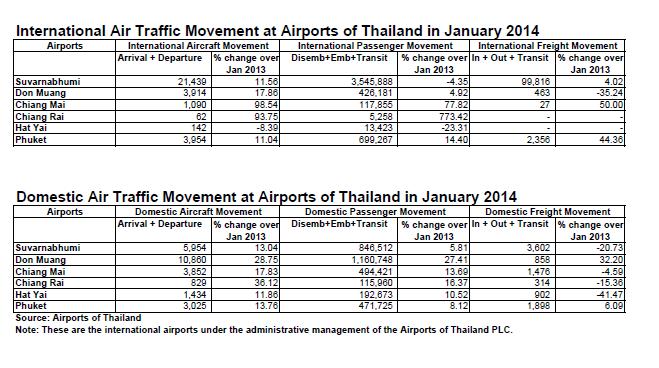
26 Feb, 2014
Jan 2014 Airport Stats Released: LCCs, Phuket Prove Saviours for Thai Aviation Sector
BANGKOK – International passenger movements at Bangkok’s secondary airport at Don Muang as well as at Phuket airport reported increases in January 2014 over January 2013, helping to offset a 4.3% decline in international passenger movements at Thailand’s main gateway airport, Suvarnabhumi.
Don Muang now serves Air Asia, Thai Air Asia, Nok Air and a host of other low-cost airlines, which are becoming a major saving grace for Thai travel & tourism industry. Phuket, in turn, has become firmly entrenched as Thailand’s second major gateway.
International passenger movements include the total of inbound, outbound and transit passengers, both Thais and foreigners. The figure is only a broad indicator and complements the more fine-tuned figures of inbound/outbound arrivals compiled by the Immigration Department, Royal Thai Police, from all international border checkpoints.
Although travel & tourism has certainly been impacted by the political unrest in Thailand, they bear up the argument of the Tourism Authority of Thailand and the private sector that the unrest is mainly confined to Bangkok, while the secondary destinations in the provinces are largely unaffected.
All airports and transportation systems nationwide have been operating normally throughout the now nearly three-month standoff.
Overall, international passenger movements at all the airports under the AoT PLC management totalled 4,807,872 in January 2014, a decline of -0.03% over January 2013. Domestic passenger movements in the same period were 3,282,039, up 14.91%.
Chiang Mai airport has also shot up as an international gateway, with a nearly doubling of international aircraft movements to 1,090, and a 77.8% surge in international passenger movements to 117,855 in January 2014.
As reported earlier by Travel Impact Newswire, the statistics are clear indicators of three critical trends that will shape the fortunes of travel & tourism over the rest of this decade: 1) Reduced dependence on main commercial and capital cities as primary gateways of international visitors; 2) Emergence of secondary cities; and 3) increased facilitation of low-cost airlines as conduits of positive change in the industry.




Liked this article? Share it!